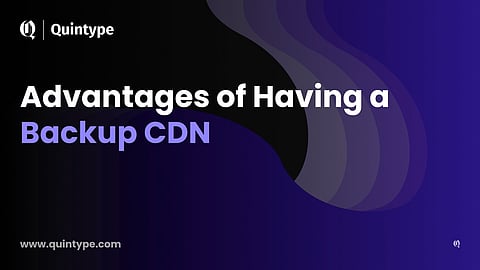5 Reasons Why You Need a Back-Up Content Delivery Network to Increase Readership
Imagine the catastrophic aftermath of a cyberattack that compromises your confidential content. Consider the repercussions of subpar content performance that decreases your reader base. For any newsroom, these scenarios are among the most formidable challenges that could detrimentally impact brand reputation and business operations.
Fortunately, deploying a Content Delivery Network (CDN) can enhance content performance, reduce costs, and bolster cybersecurity measures. A CDN is a critical infrastructure upgrade for digital newsrooms striving to deliver content to a global audience.
By caching content—including text, images, and videos—across a network of backup servers worldwide, CDNs facilitate quicker and more consistent content delivery. This ensures readers experience minimal loading times and enhanced overall site performance.
This article is a comprehensive guide to understanding the benefits of a backup CDN and how it contributes to attracting more readers to your news site.
What is a Content Delivery Network (CDN)?
A Content Delivery Network (CDN) is a cluster of geographically dispersed servers that work collaboratively to deliver digital content quickly. A CDN allows the quick transfer of assets needed for loading Internet content, including HTML pages, javascript files, stylesheets, images, and videos.
The primary function of these servers is to store a cached version of your content in multiple locations worldwide. This geographical positioning reduces latency by reducing the physical distance the data travels, enhancing user experience by speeding up page load times, and increasing content availability and redundancy.
How Does a CDN Work?
When a reader accesses your content, the CDN technology redirects their request from the site’s primary hosting server to the closest server in the network based on the geographic location of the user.
This speeds up the delivery process and distributes the load, preventing any single server from becoming a bottleneck during high-traffic situations. It optimizes the server infrastructure to speed up the content delivery process.
Imagine this scenario: You urgently need to place an order from a vendor a few kilometers away, but your local delivery service fails to meet your request. The logical step? Switch to an alternative provider who can efficiently complete the task, ensuring timely delivery. This scenario mirrors the function of a Content Delivery Network (CDN).
A CDN enhances your website's and app’s performance by intelligently distributing your content across a network of servers located around the globe.
It ensures that regardless of where your users are, the content they access is delivered from the nearest server location, significantly reducing load times and improving their overall experience.
When someone visits your website or uses your app, the CDN automatically routes their requests to the closest server. This accelerates the delivery and reduces the strain on any single server, optimizing load distribution and enhancing website stability during traffic surges.
A CDN helps maintain high engagement levels, ensure customer satisfaction, and improve SEO rankings due to faster page load times. In essence, a CDN is your behind-the-scenes ally in delivering high-quality digital experiences reliably and swiftly across different geographic locations.
Advantages of Back Up CDN
According to Cloudflare, one of the world's fastest CDN networks, websites that use CDNs have a 50% reduction in page loading time. Through more efficient data handling and reduced bandwidth demands, CDNs decrease operational costs, freeing up resources that can be redirected towards other strategic areas such as content development or marketing. In addition to this, here are the benefits of a backup CDN.
Speed and User Experience
A CDN significantly accelerates your website's load time. A faster site enhances the overall user experience, encouraging visitors to engage more thoroughly with your content, which can lead to higher conversion rates and customer retention.
Boosting Website Resilience
Traditional website setups often rely on a single main server, which can become a point of failure during high-traffic periods. A CDN mitigates this risk by distributing the load across multiple servers. This dispersion makes your website less likely to crash and enhances its capability to easily handle spikes in traffic.
A CDN ensures continuous service availability despite common network issues like hardware failures and congestion by employing load balancing and intelligent failover within its network of globally distributed data centers.
Optimizing Load Distribution
Load balancing is a technique used within data centers by CDNs to distribute incoming traffic across all available servers. Effective load balancing increases processing speeds and maximizes server capacity utilization, maintaining an efficient and robust service.
Reducing Latency and Network Traffic
A CDN acts as an intermediary between users and the website’s origin servers, significantly cutting down the traffic that reaches the origin by caching content in multiple server locations closer to end users.
This setup reduces latency—delays experienced while data travels from source to destination—because the content is served from a location near the user, not repeatedly fetched from the origin servers. As a result, CDNs enhance the speed of content delivery and reduce the load on the origin servers, saving bandwidth.
Security Against Cyber Attacks
From a cybersecurity perspective, CDNs provide an essential defense mechanism. They protect against Distributed Denial of Service (DDoS) attacks and other cyber threats, ensuring that your content and user data remain secure. This added layer of security is crucial for maintaining the integrity and trustworthiness of your news platform.
Quintype’s Backup CDN
Quintype has partnered with Cloudflare, a leading global Content Delivery Network (CDN) provider, to bolster its clients' digital defenses and delivery capabilities.
Integrating Cloudflare's Enterprise plan into its service offerings, Quintype ensures comprehensive protection against Distributed Denial of Service (DDoS) attacks at level 3 and 7.
With Cloudflare's advanced CDN technology, Quintype clients enjoy enhanced reliability and performance, ensuring their digital operations remain uninterrupted and efficient.
Choosing Quintype’s BOLD CMS, equipped with Cloudflare's CDN, means opting for an extra layer of security and efficiency. This strategic decision allows newsrooms to maintain high availability and quick content delivery, even during peak traffic or cyber-attack scenarios.

